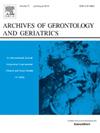Association of the 25-question Geriatric Locomotive Function Scale with all-cause mortality in older adults: The Nagahama study
IF 3.5
3区 医学
Q2 GERIATRICS & GERONTOLOGY
引用次数: 0
Abstract
Backgrounds
Locomotive syndrome is a condition in which a person is at risk of requiring nursing care due to musculoskeletal disorders. The 25-question Geriatric Locomotive Function Scale (GLFS-25) was developed to determine the severity of locomotive syndrome. In this study, we aimed to determine the prognostic significance of the GLFS-25 for all-cause mortality.
Methods
The study participants consisted of 3,447 community residents aged ≥65 years. All-cause mortality was determined using residential registry records. Skeletal muscle mass assessed via bioimpedance methods was considered in the analysis as a confounding factor.
Results
During a mean follow-up period of 3,236 days (30,566 person–years), 288 cases of all-cause mortality occurred. When participants were categorized by the GLFS-25 score [grade 1: <7 points (n = 1,948); grade 2: ≥7 to <16 points (n = 894); grade 3: ≥16 points (n = 605)], their survival probability decreased linearly with increasing grade (log-rank test P = 0.014). In a Cox proportional hazards model adjusted for confounding factors, including low skeletal muscle mass, GLFS-25 grade 3 was identified as an independent risk factor for all-cause mortality (hazard ratio: 1.60; P = 0.007) in the subpopulation aged ≥70 years but not in the overall population (P = 0.062). The hazard ratio for all-cause mortality with GLFS-25 grade 3 and low skeletal muscle mass combined was 2.66 (P < 0.001).
Conclusion
The GLFS-25 is independently associated with all-cause mortality in older adults. Using this questionnaire to assess locomotive syndrome could be useful for identifying individuals at risk.

25 个问题的老年运动功能量表与老年人全因死亡率的关系:长滨研究
背景运动机能综合征是一种由于肌肉骨骼失调而有可能需要护理的疾病。老年运动机能量表(Geriatric Locomotive Function Scale,GLFS-25)包含 25 个问题,用于确定运动机能综合征的严重程度。本研究旨在确定 GLFS-25 对全因死亡率的预后意义。全因死亡率通过居民登记记录确定。结果在平均 3,236 天(30,566 人年)的随访期间,288 例全因死亡病例发生。根据 GLFS-25 评分对参与者进行分类[1 级:7 分(1 948 人);2 级:≥7 分至 16 分(894 人);3 级:≥16 分(605 人)],随着评分的增加,参与者的生存概率呈线性下降趋势(log-rank 检验 P = 0.014)。在对混杂因素(包括低骨骼肌质量)进行调整的 Cox 比例危险模型中,GLFS-25 3 级被确定为年龄≥70 岁亚人群全因死亡的独立危险因素(危险比:1.60;P = 0.007),但在总体人群中并非如此(P = 0.062)。结论 GLFS-25 与老年人的全因死亡率密切相关。使用该问卷评估运动综合征有助于识别高危人群。
本文章由计算机程序翻译,如有差异,请以英文原文为准。
求助全文
约1分钟内获得全文
求助全文
来源期刊
CiteScore
7.30
自引率
5.00%
发文量
198
审稿时长
16 days
期刊介绍:
Archives of Gerontology and Geriatrics provides a medium for the publication of papers from the fields of experimental gerontology and clinical and social geriatrics. The principal aim of the journal is to facilitate the exchange of information between specialists in these three fields of gerontological research. Experimental papers dealing with the basic mechanisms of aging at molecular, cellular, tissue or organ levels will be published.
Clinical papers will be accepted if they provide sufficiently new information or are of fundamental importance for the knowledge of human aging. Purely descriptive clinical papers will be accepted only if the results permit further interpretation. Papers dealing with anti-aging pharmacological preparations in humans are welcome. Papers on the social aspects of geriatrics will be accepted if they are of general interest regarding the epidemiology of aging and the efficiency and working methods of the social organizations for the health care of the elderly.

 求助内容:
求助内容: 应助结果提醒方式:
应助结果提醒方式:


